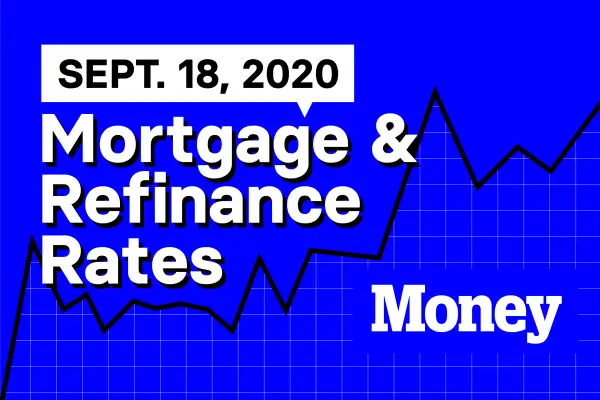Here Are Today's Best Mortgage & Refinance Rates for September 18, 2020

Borrowers with 700 credit scores were quoted an average rate of 3.457% to secure a 30-year fixed-rate purchase mortgage on Thursday, according to Money's survey of over 8,000 lenders across the United States. At this credit score, roughly the national average, the rate for a 30-year refinance was 4.471%. Our rates include discount points and are for borrowers putting 20% down.
| 30-year fixed-rate purchase mortgage |
| 3.457% |
| Rate of September 17, 2020 |
Borrowers in Kentucky were quoted the lowest mortgage rates on Thursday—at 3.426%. Those in Colorado saw the highest average rate at 3.79%. Nationwide, borrowers with the highest credit scores, 740 and above, were quoted rates averaging 3.139%, while those with credit of 640 or below were given rates of 4.923%—a 1.784 percentage point spread.
You may be able to negotiate a lower rate if you shop around or if you have other accounts with the lender. (Money's picks for the best mortgage lenders are here.) Currently, some banks are hiking up advertised rates to keep demand in check, so you may be offered a lower rate if you reach out directly.
Freddie Mac's widely quoted Primary Mortgage Market Survey put rates at 2.87% with 0.8 points paid for the week ending September 17. The mortgage purchaser's weekly survey reflects borrowers who put 20% down on conforming loans and have excellent credit.
Refinance rates today
Money's survey also shows that the offered rate for a 30 year refinance for someone with a 740 credit score was 3.741% on Thursday. Last September, the average mortgage rate (including fees) was 3.922%.
| 30-year fixed-rate mortgage refi |
| 3.741% |
| Rate of September 17, 2020 |
A homeowner with a $200,000 mortgage balance currently paying 3.922% on a 30-year loan could potentially cut their monthly payment from $946 to $925 by financing at today's lower rates. To determine if it's worth it to refinance your mortgage, also consider the closing fees you paid on your current mortgage, how much your new lender is charging and how long you have left on your loan term. (Our picks for the best lenders for refinancing are here).
What else is happening in the housing market right now?
Single-family housing starts were up 4.1% for the month of August, according to a report by the U.S. Census Bureau in conjunction with the Department of Housing and Urban Development. This represents an annualized rate of 1,021,000 units. Single-family permits rose as well and are up almost 7% year-to-date.
"Low interest rates and solid demand are spurring single-family construction growth, which makes up the bulk of the housing market," said Robert Dietz, chief economist for the National Association of Home Builders.
However, housing starts were down overall in August due to a decline in multifamily construction. Start on buildings with five or more units in particular were down 8.3% year-to-date. Building permits overall were down 0.9% to an annualized rate of 1.47 million units. Single family permits, however, were up 6% to a rate of 1.04 million, while multi-family permits were down 14%.
The Week in Review
This week in housing and economic news.
The housing market continued to show signs of strength this week as homebuyer demand continued to push home prices up. According to real estate brokerage Redfin, the median home sale price increased 13% year-over-year to $319,178, the largest increase the brokerage has seen since October 2013. Demand is so high and supply is so tight that almost half of homes under contract had offers within two weeks.
Median listing prices were also up, according to Realtor.com, increasing 11.1% from last year. With homes selling 11 days faster on average than during the same week last year, concerns about inventory remain. Natural disasters, such as the wildfires on the west coast and hurricanes in the Gulf coast, have led to a decrease of homes coming onto the market. Housing inventory is down 39% year-over-year.
There was some good news about housing inventory as the National Association of Home Builders released its Builder Sentiment survey indicating that home builders have increased confidence in the single-family, newly built home sector. The survey reached an index of 83, the highest level ever in the history of the survey, indicating a positive outlook for the housing inventory crunch to ease somewhat over the next 6 months.
Meanwhile, the number of loans in forbearance dropped to 7.01% of mortgage loans, according to the Mortgage Banker Association, representing about 3.5 million homeowners still taking advantage of the payment deferral plans. While more homeowners leaving forbearance plans outnumbered those requesting to enter the payment deferral plans, the percentage of homeowners requesting relief ticked up from 0.9% to 0.11%.
At the same time, the MBA's Builder Application Survey for August saw a year-over-year increase of 33% in loan applications for newly built homes, with home sales selling at an annualized rate of 871,000 units. Despite the increase in loan applications for new homes, the overall volume of mortgage loan applications was down for both purchase and refinance loans for the week ending September 11. Purchase loans decreased by 1%, while refinance loans were down 4%. However, both categories were up over last year's numbers, with increases of 6% and 30% respectively.
The Federal Reserve wrapped up its September meeting with renewed calls for additional government assistance, but also with a renewed commitment to keeping interest rates between the 0% to 0.25% range for an extended period of time. The Fed's policy has now shifted slightly to keep rates low until inflation surpasses the central bank's target of 2%. The Fed also pledged to continue purchasing mortgage-backed securities to ensure market liquidity.
Finally, the initial unemployment claims came in slightly lower than expected at 860,000 claims for the week ending September 12. It's the third week in a row that claims have been under 1 million. Despite the decrease, high unemployment remains the biggest concern in terms of an economic recovery going forward.

